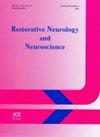当前脑卒中康复治疗干预措施的科学基础和有效成分。
IF 1.6
4区 医学
Q4 NEUROSCIENCES
引用次数: 1
摘要
背景尽管在中风的治疗和管理方面取得了巨大进展,但中风后恢复运动和功能结果仍然是一个重大的临床挑战。鉴于运动康复中使用的方法范围广泛,一些评论强调,不同干预措施缺乏明确的科学依据,这是导致研究结果不理想的一个关键因素。目的了解当前治疗干预措施的有效成分。方法:我们对2019-2020年2年期间中风康复的随机对照试验进行了分析。结果有三个主要发现:(i)与之前的报道一致,大多数研究没有提供为什么该治疗有效的明确理由,(ii)大多数治疗干预措施都提到了多种活性成分,并且所提到的活性成分与研究中测量的活性成分之间没有密切的对应关系,以及(iii)涉及一种以上治疗方法的多模式方法往往以特别的方式结合在一起,这表明缺乏有针对性的方法。结论这些结果强调了加强基础科学和临床研究之间跨学科联系的必要性,以及结构化开发和测试治疗方法以寻找更有效的治疗干预措施的必要性。本文章由计算机程序翻译,如有差异,请以英文原文为准。
Scientific basis and active ingredients of current therapeutic interventions for stroke rehabilitation.
BACKGROUND
Despite tremendous advances in the treatment and management of stroke, restoring motor and functional outcomes after stroke continues to be a major clinical challenge. Given the wide range of approaches used in motor rehabilitation, several commentaries have highlighted the lack of a clear scientific basis for different interventions as one critical factor that has led to suboptimal study outcomes.
OBJECTIVE
To understand the content of current therapeutic interventions in terms of their active ingredients.
METHODS
We conducted an analysis of randomized controlled trials in stroke rehabilitation over a 2-year period from 2019-2020.
RESULTS
There were three primary findings: (i) consistent with prior reports, most studies did not provide an explicit rationale for why the treatment would be expected to work, (ii) most therapeutic interventions mentioned multiple active ingredients and there was not a close correspondence between the active ingredients mentioned versus the active ingredients measured in the study, and (iii) multimodal approaches that involved more than one therapeutic approach tended to be combined in an ad-hoc fashion, indicating the lack of a targeted approach.
CONCLUSION
These results highlight the need for strengthening cross-disciplinary connections between basic science and clinical studies, and the need for structured development and testing of therapeutic approaches to find more effective treatment interventions.
求助全文
通过发布文献求助,成功后即可免费获取论文全文。
去求助
来源期刊
CiteScore
5.40
自引率
3.60%
发文量
22
审稿时长
>12 weeks
期刊介绍:
This interdisciplinary journal publishes papers relating to the plasticity and response of the nervous system to accidental or experimental injuries and their interventions, transplantation, neurodegenerative disorders and experimental strategies to improve regeneration or functional recovery and rehabilitation. Experimental and clinical research papers adopting fresh conceptual approaches are encouraged. The overriding criteria for publication are novelty, significant experimental or clinical relevance and interest to a multidisciplinary audience. Experiments on un-anesthetized animals should conform with the standards for the use of laboratory animals as established by the Institute of Laboratory Animal Resources, US National Academy of Sciences. Experiments in which paralytic agents are used must be justified. Patient identity should be concealed. All manuscripts are sent out for blind peer review to editorial board members or outside reviewers. Restorative Neurology and Neuroscience is a member of Neuroscience Peer Review Consortium.

 求助内容:
求助内容: 应助结果提醒方式:
应助结果提醒方式:


